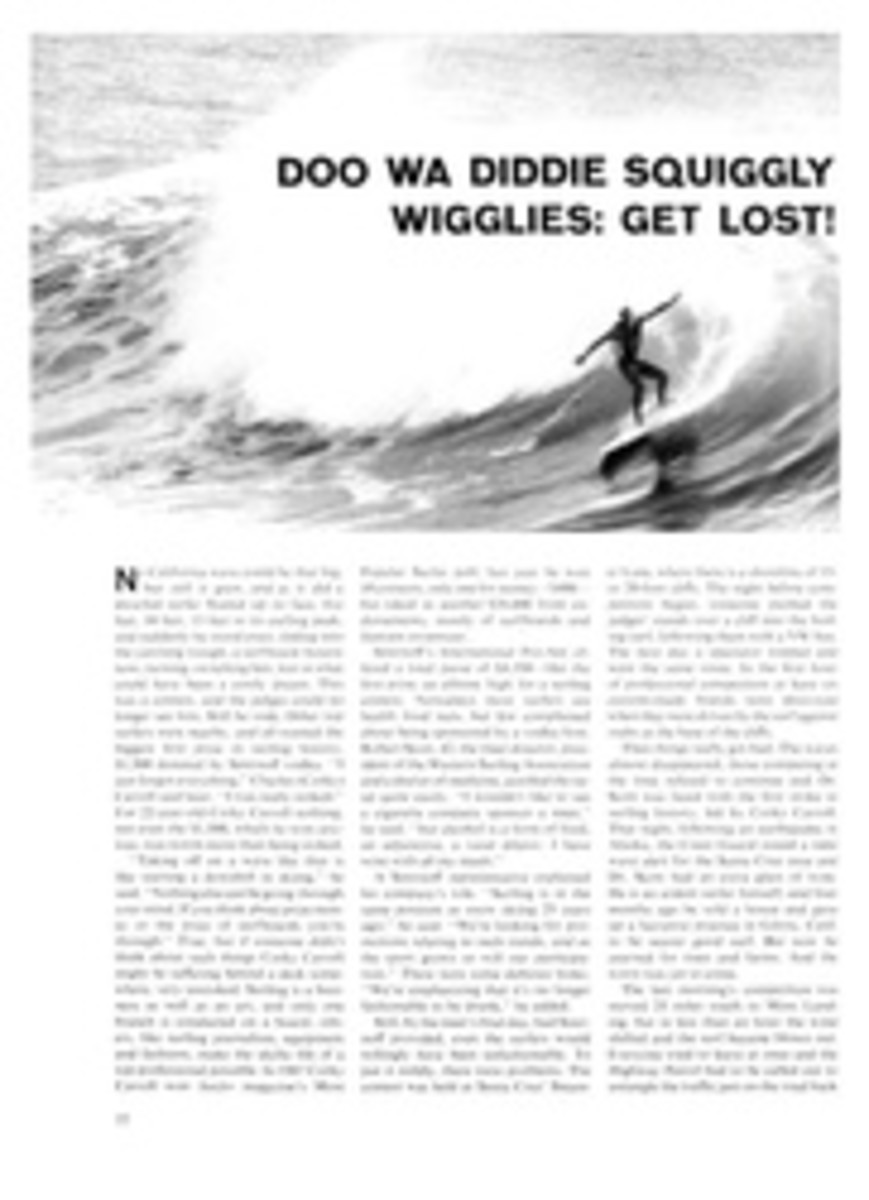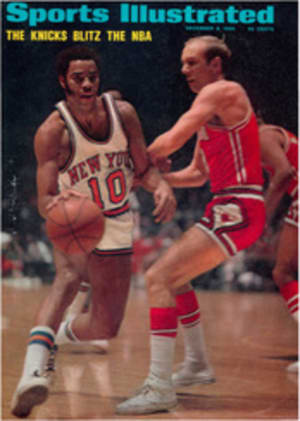
A PTA meeting is tougher
Even on Friday night Mrs. Doris Brown was at ease. At dinner she smiled sweetly as the girls she would run against the next day stopped to say hello, and how are your ankles, and what kind of training have you been doing and, well, guess I'll see you tomorrow, huh? "Uh, sure," said Doris. Then she and three teammates from Seattle's Falcon Track Club took a mile walk over to a Lucky grocery store, where they shared half a gallon of Neapolitan ice cream and three yogurts. They returned an hour later, giggling. "Gosh," Doris said, "now I'll have to go upstairs to my room and do some exercises. Got to get this weight off before tomorrow."
She didn't exercise, and the next day, when she would successfully defend her National AAU Women's Cross-Country title at Centinela Park in Inglewood, a suburb of Los Angeles, she lay in bed until 10, only three hours before the race. "I don't know how she does it," says teammate Nancy Main. "She's so relaxed. All she says is that she will beat them. And she does."
Indeed she did, but Brownie is getting more and more competition. Kids are popping up all over the place who feel that running two miles or more over hill and dale is a very feminine thing to do. There is Francie Larrieu, a bouncy 17-year-old from Sunnyvale, Calif., who worries that she may have missed something by not going out for cheerleader, but finally says, "I guess I'm part of what you could call the in-crowd. And, no kidding, I like boys more than running." And 21-year-old Cheryl Bridges from Pontiac, Mich., who claims "the only time I get defensive is when I see those voluptuous, well-built actresses on TV, and then I look at myself and wonder what happened. All I got are legs. But I guess I'm lucky. My husband's a leg man." And 16-year-old Maria Stearns, who will be happy when she gets her braces off because that may save two seconds but who will never, never cut her long blonde hair, no matter how many seconds that might save. And her teammate on the Santa Monica AA, Pat Cole, a 21-year-old UCLA senior. "I don't have to worry about my image and about trying to look like a girl when I run," she says defiantly.
Women's cross-country is both crowded and in. Five years ago, at the second AAU championships, there were 40 entrants. Last weekend there were 542. "It's like pierced ears," says one girl. "A few years ago only certain people did it. But now it's acceptable. Same with cross-country." An age-group program that has them running as early as 6 drew a field of 85 girls 9 or under who ran a¾-mile course. Lezli Peterson of the San Jose Cindergals, won in 4:55.1. And there were 129 10- and 11-year-olds who ran a mile. Doreen Assumma of the Rialto (Calif.) Roadrunners, won in 5:47.2. All the Dashers and Meteors and Comets, even Poison Spiders, made the lobby of the Sheraton Inn-Los Angeles Airport more dangerous than the Santa Monica freeway at rush hour. She was there, each girl claimed, to run. But first there were more important things. Like visiting Disneyland. And the swimming pool. And playing handies and tag, and catch-one-catch-all, and race ya up to the seventh floor—ready, set, go.
They tell stories about these little girls. Like the 6-year-old who clotheslined anyone who tried to pass her. And the 9-year-old who got tired and started walking up a hill—until she spotted a man with a camera, at which point she sprinted madly. And the 7-year-old who stopped in her tracks—and started crying—when someone passed her on the final straight. And the 4-year-old who was there, according to one official, "just to be exploited by her father. And it worked. He got his picture in all the papers."
Some, of course, are pushed by their parents. But more typical is Robin Campbell of Washington, D.C.'s Sports International, a winner of five straight races before finishing ninth in the 10-11 division last weekend. "I beat everyone in gym, so I started to run," she says. "I like it because of the trophies and because I want to travel outside Washington."
"Well, what's been your biggest thrill?"
"Winning at Fairfield."
"Not the National Junior Championship?"
"Nope."
"Why?"
"Because Fairfield gave the biggest trophies."
As she approaches the years of, say, Doris Brown, Robin Campbell will learn there is more to women's track, and as she does, she might make a bow in the direction of Brownie, the pioneer U.S. woman distance runner. Now 27 and a part-time teacher, part-time student at Seattle Pacific College, Doris easily won her second straight title, finishing nearly 100 yards ahead of Cheryl Bridges, with a 10:56.2 for the two-mile course. But, after all, she has won the Women's International Cross-Country Championship the three years (1966-68) it has been held and is the world-record holder in the women's indoor mile [4:40.0].
Someone suggested to Mrs. Brown that the race was no harder than a PTA meeting.
"Not that tough," she said.
"Do you feel like an old lady, beating back all the kids?"
"The only time I feel like a grandmother," Brownie said, "is when TV commentators call me that old veteran."
The week before the championships it was business as usual for Brownie—five miles in the morning around Seattle's Green Lake and over the hills of Woodland Park and, as always, each hill meant something. The first was for Francie Larrieu, whom she expected to be her toughest competition. The second was for Maria Gommers, the Dutch girl whom Brownie considers the best woman distance runner. And the third was "for me," she says. "I knew if I was going to win I had to work on that final climb."
Then, at night, she ran over one of the many trails through the woods and the beaches by Puget Sound. On Wednesday, a tapering-off day, she and her coach, Dr. Ken Foreman, went for a five-mile jog through the Arboretum on the University of Washington campus. It was a pleasant run among Japanese maples and Japanese red pines and Japanese katsura trees.
"Did you see the cherry trees lining the creek?" Dr. Foreman said afterward. "Yes," said Brownie, "and there are still rhododendron in bloom, and the dogwood has got its second blossom. I don't know how it does it."
Later, Dr. Foreman smiled when he was reminded of the conversation. "But it's true," he said. "The women runners are tremendously sensitive people. They are an amazing transition from the typical brute, from the archetype that all those who don't know women's track claim them to be."
"Definitely," Brownie says. "Girls now always make sure they look well, that they have makeup on and that their hair is combed and that maybe they have a ribbon in their hair.
"But still," she continues, "running is a matter of enjoyment and a means of fulfilling your needs, to at least partially give back to others what they have given to you. Even the books I read that inspire me in my running are those that talk about human character. I mean things like [Maxwell] Maltz' Psycho-Cybernetics and [Paul] Tournier's The Strong and The Weak and [Robert W.] Russell's To Catch an Angel. All of them teach you how to make yourself better. They're positive books, and not abstractly positive but with reasons. There is even Nietzsche. He says, 'If we have our own why of life, we shall get along with almost any how.' I have a why. To win an Olympic medal [in the 1,500-meter run]. I figure I can do anything to get it."
It is a new age, and the problems of the young will never be those of Doris Brown or Cheryl Bridges or Pat Cole, each of whom was barred from her high school track. Nowadays girls aren't allowed to run unless they're girls. "I was insulted when the doctor said he had to check me," Francie Larrieu said, referring to the standard hormone test which is given before most major meets. "He said he had to make sure I was a girl. My gosh, couldn't he see?" If, in fact, he couldn't, he was the only one.
PHOTO
CHAMPION DORIS BROWN (LEFT) HELPS CHERYL BRIDGES, WHO FINISHED SECOND
TWO PHOTOS
LITTLE GIRLS, like those above warming up or the group below in full stride, are turning to cross-country in increasing numbers. Nine-and-unders run three-quarters of a mile, 10-to-13s a mile.

